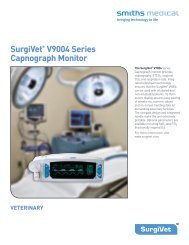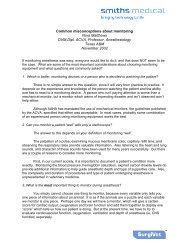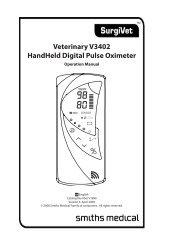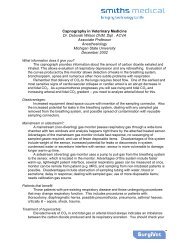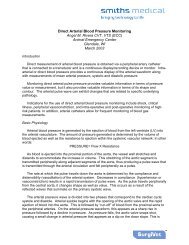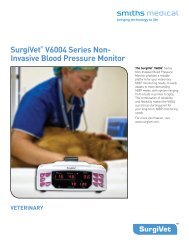Understanding Anesthetic Delivery Systems - SurgiVet
Understanding Anesthetic Delivery Systems - SurgiVet
Understanding Anesthetic Delivery Systems - SurgiVet
You also want an ePaper? Increase the reach of your titles
YUMPU automatically turns print PDFs into web optimized ePapers that Google loves.
circuit. These components are arranged to allow movement of the gas mixture in one direction.<br />
The expired gas mixture will always pass thorough the absorber circuit before inhalation by the<br />
patient.<br />
Non-Rebreathing System<br />
In a Non-Rebreathing system little to no exhaled gases are recirculated. The gases are<br />
evacuated by the scavenge system. Usually used for patient less than 7kgs(15 lbs). A nonrebreathing<br />
system offers little resistance to the patient when breathing, a significant advantage<br />
to smaller patients. A non-rebreathing system has less drag on the ET tube than does a<br />
rebreathing system. Due to the higher flow rates needed for a non-rebreathing the cost does<br />
increase as compared to a rebreathing system. The components of a non-rebreathing system<br />
differ from a rebreathing system as that there are no unidirectional valves, manometer, or<br />
absorber circuit. The use of a reservoir bag allows for bagging when needed and a buffer<br />
between the scavenging system.<br />
Scavenging System<br />
The scavenging system removes the waste anesthetic gases from the anesthetic breathing<br />
system and reduces the contamination of the workplace. There are two types of scavenging<br />
systems. The passive system uses the positive pressure of the anesthetic machine to push the<br />
gas into the system. The other is an active system, which uses suction created by a vacuum<br />
pump or fan to draw the gas into the system. Both systems are effective when correctly<br />
assembled, operated, and maintained properly. However, the active system appears to be the<br />
most efficient in removing waste gases.<br />
All of the components of the anesthetic delivery system, especially the anesthetic machine and<br />
breathing system, should be tested prior to use to ensure that they are functioning properly. This<br />
will help prevent anesthetic complications associated with the anesthetic machine and breathing<br />
systems during the procedure. Preventative maintenance and cleaning of the anesthetic<br />
delivery system is extremely important to its longevity and proper function. Knowing the<br />
functions and being able to follow the flow of gases through the anesthesia delivery system will<br />
aide when troubleshooting problems.<br />
Testing Procedures<br />
1. All components of the anesthesia delivery system need to be visually inspected daily.<br />
a. Check all fittings and connections for proper fit.<br />
b. Check unidirectional valves; ensure that the discs are present and properly<br />
placed.<br />
c. Check all hoses, tubing, and rebreathing for any deterioration.<br />
d. Check vaporizer level.<br />
2. Gas Source<br />
a. Open valve on tank(s) to verify that the tank has 500 psi or more in it. If less then<br />
500 then tank(s) needs to be changed to ensure proper line pressure is<br />
maintained in the system.<br />
b. Check for any high-pressure leaks and correct if any are present.<br />
3. Anesthesia machine and Circle Breathing System


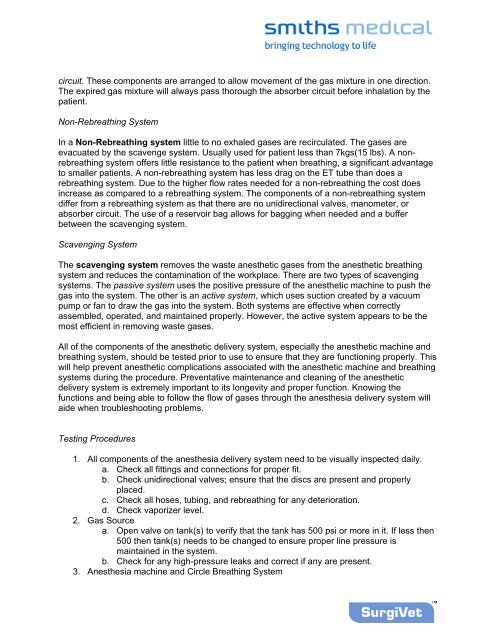
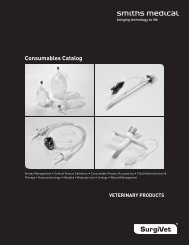
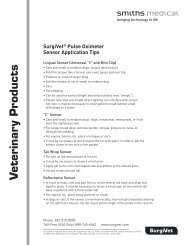
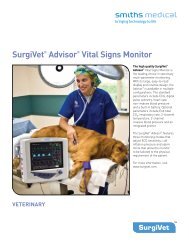
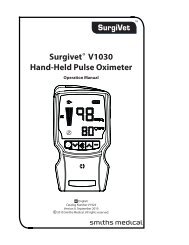
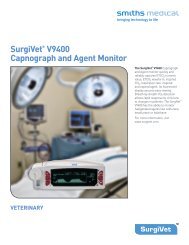
![Redemption Form [PDF] - SurgiVet](https://img.yumpu.com/37386077/1/190x245/redemption-form-pdf-surgivet.jpg?quality=85)
![Redemption Form [PDF] - SurgiVet](https://img.yumpu.com/37386066/1/190x245/redemption-form-pdf-surgivet.jpg?quality=85)
